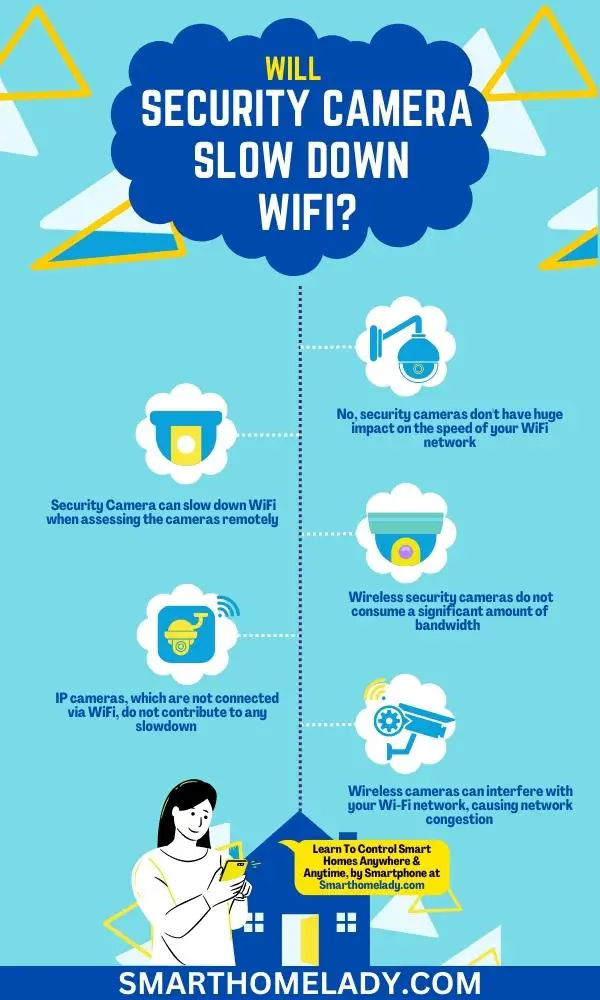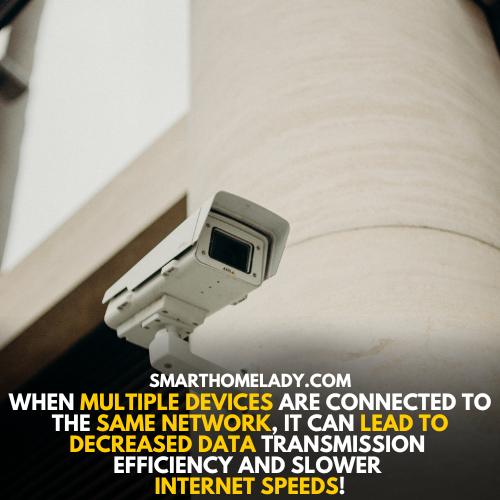As a homeowner, the decision to install security cameras is often driven by a desire for enhanced safety and protection.
However, one common concern that arises is whether security cameras slow down WiFi connection or not.
In this article, we will explore the impact of security cameras on WiFi performance.
So let’s dive in and unravel the mysteries surrounding this important question: Will security cameras slow down WiFi?

Contents
- 1 Do Security Cameras Slow Down WiFi
- 2 Does IP Camera Slow Down Internet
- 3 Do Wireless Cameras Slow Down the Internet
- 4 Do WiFi Security Cameras Slow Down the Network
- 5 How Much Bandwidth Does A Security Camera Use
- 6 Calculation of the Bandwidth Usage by Wi-Fi Cameras – Formula
- 7 Factors That Affect Security Camera Bandwidth Consumption
- 8 Ways For The Reduction Of Security Camera Bandwidth Usage
- 8.1 1. Opt For the Right Compression Format
- 8.2 2. Choose The Right Resolution For Security Camera
- 8.3 3. Reducing the Frame Rates To Reduce Bandwidth Usage
- 8.4 4. Select The Cameras With Motion Detection Features
- 8.5 5. Isolation Of All Cameras on Separate Network
- 8.6 6. Install A Security Camera Systems To Reduce Bandwidth Usage
- 8.7 Do security cameras use a lot of WiFi?
- 8.8 Do ring cameras slow down WiFi?
- 8.9 How far can a security camera be from WiFi?
- 8.10 How many Wi-Fi cameras can a router handle?
- 8.11 Will wireless security cameras interfere with WiFi?
- 9 Conclusion
Do Security Cameras Slow Down WiFi
No, security cameras don’t have any impact on the speed of your WiFi network. However, it is important to note that it can slow down WiFi when assessing the cameras remotely or particularly if they are continuously streaming high-quality video footage.
If you are not accessing the cameras outside of your local network, there should be no noticeable effect on your WiFi speed.
Additionally, wireless security cameras, unlike WiFi-connected cameras, do not consume a significant amount of bandwidth and therefore have minimal impact on your internet speed.
Similarly, IP cameras, which are not connected via WiFi, do not contribute to any slowdown as they do not utilize precious bandwidth.
While it is true that wireless security cameras can cause WiFi interference, the impact is typically less and should not cause significant disruptions to your network.
Does IP Camera Slow Down Internet
Yes, there is a possibility that IP cameras can slow down your internet speed due to the amount of data they transmit while streaming video footage. But it doesn’t mean it will slow down the internet in every case. It depends on a few factors.
These cameras continuously capture and send video data over the network to a designated storage device or cloud service.
The higher the video resolution and frame rate, the more data is generated and transmitted, resulting in increased network traffic.
It can potentially saturate your internet bandwidth and lead to slower internet speeds for other devices on the network.
Solution
To mitigate this issue, you can consider implementing network optimization techniques such as;
- Using a separate network for your IP cameras
- Upgrading your internet plan to accommodate higher data usage
- Adjusting the camera settings to lower resolution or frame rate if it doesn’t compromise your security requirements.
IP cameras can slow down your internet speed, particularly during remote viewing.
When you access the live feed or recordings from your IP camera remotely, it requires uploading the video data from the camera to the internet. This process consumes a significant amount of upload bandwidth, which can lead to a decrease in overall internet speed.
Must Read: Can We Use Security Cameras With Starlink
Do Wireless Cameras Slow Down the Internet
Yes, you may notice a decrease in your internet speed when using wireless cameras.
This is because wireless cameras can interfere with your Wi-Fi network, causing network congestion and potentially slowing down your internet speed.
The interference occurs because both the camera and your Wi-Fi router use the same frequency band to transmit data.
When multiple devices are connected to the same network, it can lead to decreased data transmission efficiency and slower internet speeds.

Ways To Minimize The Impact
However, there are ways to optimize your camera settings to minimize the impact on your internet speed.
- You can adjust the resolution and frame rate of your camera to reduce the amount of data being transmitted.
- Additionally, positioning your camera closer to the Wi-Fi router or using a wired connection instead of a wireless one can also help improve performance.
By taking these steps, you can ensure that your wireless cameras have minimal impact on your internet speed while still maintaining a secure surveillance system.
Do WiFi Security Cameras Slow Down the Network
No, WiFi security cameras do not typically slow down the network as they use their own dedicated bandwidth to transmit and receive data.
However, if multiple cameras are connected to the same network and all are streaming simultaneously, it may impact the network speed.
Factor Impacting WiFi Performance For WiFi Security Cameras
While WiFi security cameras do not inherently slow down the network, certain factors can affect their performance and consequently impact network speed.
- The main factor is the bandwidth capacity of the network. If the network has limited bandwidth and multiple cameras are connected and streaming high-resolution videos simultaneously, it can result in reduced network speed and performance.
Therefore, it is important to consider the number of cameras and the available bandwidth when setting up a WiFi security camera system to ensure optimal functioning and network speed.
Additionally, other devices connected to the network, such as smartphones, tablets, or computers, can also consume bandwidth and potentially affect the overall network performance.
Must Read: How Much WiFi Do I Need For Security Cameras?
How Much Bandwidth Does A Security Camera Use
The bandwidth usage of security cameras can vary significantly depending on various factors. Some cameras consume as little as 5 Kbps, while others can go as high as 6 Mbps and beyond.
IP cameras, on the other hand, generally require around 8 Mbps or less, with most of the usage being local to the network.
However, to ensure the smooth functioning of the IP camera system, it is recommended to have a minimum upload speed of 2.0 to 2.5 Mbps per camera.
It is important to consider that the impact on internet speed can be influenced by factors such as camera resolution, compression codecs, and the number of cameras in use.
Higher resolutions and frame rates will result in greater bandwidth usage, while compression techniques can help reduce the amount of data transmitted.
For higher-resolution videos, the internet speed required for security cameras typically ranges from 1 Mbps to 2.5 Mbps.
It is worth noting that slow internet speeds may affect the remote viewing of security cameras. Nonetheless, a minimum upload speed of 5 Mbps is generally sufficient for remote viewing purposes.
Calculation of the Bandwidth Usage by Wi-Fi Cameras – Formula
Calculating the bandwidth usage of a security camera involves several factors. These factors include the camera resolution, frame rate, compression method, and recording duration.
To determine the bandwidth usage, we can use a simple formula:
Bandwidth Usage (bits) = (Image Size in bits) x (Frames per Second)
To calculate the image size in bits, we need to consider the camera’s resolution and color depth.
By multiplying the image width, image height, and color depth in bits per pixel, we can obtain the image size in bits.
Image Size (in bits) = (Image Width) x (Image Height) x (Color Depth in bits per pixel)
For example, a camera with a resolution of 1920×1080 pixels and a color depth of 24 bits per pixel would have an image size of 49,766,400 bits or 49766.4 Kbps.
Image Size (in bits) = (1920) x (1080) x (24) = 49,766,400 bits or 49766.4 Kbps
To calculate the bandwidth usage in Mbps, we can substitute the image size in bits and frames per second into the formula mentioned earlier.
Bandwidth Usage (Bits) = (Image Size in bits) x (Frames per Second)
Bandwidth Usage (Bits) = (49,766,400) x (30) = 1492992000 Bits or 1492.992 Megabit per second (Mbps)
Additionally, consider any additional data usage, such as audio streaming or network overhead, if applicable.
Must Read: What Upload Speed Do I Need For Security Cameras?
Factors That Affect Security Camera Bandwidth Consumption
There are several factors that affect security camera bandwidth consumption. Here are a few.
1. Compression Codecs
Different compression codecs have varying levels of efficiency in reducing the size of video files, which directly affects the amount of data that needs to be transmitted over the network.
Some codecs, such as H.264 and H.265, offer significant reductions in file size while maintaining good image quality.
On the other hand, older codecs like MJPEG or uncompressed formats result in larger file sizes and higher bandwidth usage.
2. Resolution Of Security Camera
The resolution of the security camera plays a significant role in determining bandwidth consumption.
A higher resolution camera will generate larger file sizes that need to be transmitted over your network. This means that if you have multiple high-resolution cameras, it can significantly affect your overall network performance and potentially slow down your WiFi connection.
3. Frame Rate
To maximize the visual fluidity and smoothness of your security camera footage, adjusting the frame rate can be a game-changer in terms of bandwidth usage.
Higher frame rates result in smoother video playback but also increase the amount of data that needs to be transmitted over the network.
By reducing the frame rate, you can significantly decrease the bandwidth requirements without compromising image quality.
To illustrate this concept, let’s consider a scenario where we have three cameras with different frame rates: Camera A captures footage at 30 frames per second (fps), Camera B captures at 15 fps, and Camera C captures at 5 fps. In a table format:
| Camera | Frame Rate (fps) | Bandwidth Usage |
|---|---|---|
| A | 30 | High |
| B | 15 | Medium |
| C | 5 | Low |
As shown in the table above, higher frame rates result in higher bandwidth usage.
4. Number Of Your Security Cameras
The number of security cameras installed in a surveillance system can have a significant impact on bandwidth consumption.
Each camera requires a certain amount of bandwidth to transmit its video feed to the recording or monitoring device.
Therefore, the more cameras there are in the system, the more bandwidth will be consumed overall.
Must Read: What Upload Speed Do I Need For Security Cameras?
Ways For The Reduction Of Security Camera Bandwidth Usage
When it comes to reducing security camera bandwidth usage, there are several key points to consider. Let’s discuss all the ways one by one.
1. Opt For the Right Compression Format
Choosing the right compression format for your security cameras can significantly impact your WiFi speed.
Different compression formats have their own advantages and disadvantages when it comes to bandwidth usage.
Here is a comparison of H.264 and H.265 format.
| Format | Compression Efficiency | Processing Power Requirement | Compatibility | Factors to Consider |
|---|---|---|---|---|
| H.264 | Good | Moderate | Widely compatible | Balance between video quality and bandwidth consumption |
| H.265 (HEVC) | Better | Higher | May not be compatible with all systems or software | Improved compression efficiency, reduced bandwidth usage |
2. Choose The Right Resolution For Security Camera
The resolution of a security camera determines the level of detail captured in the footage and directly affects bandwidth usage.
When considering resolution options, it’s important to strike a balance between image quality and bandwidth consumption.
3. Reducing the Frame Rates To Reduce Bandwidth Usage
To decrease bandwidth usage, consider reducing the frame rates of your security camera footage.
By lowering the frame rates, you can optimize bandwidth allocation and effectively manage network traffic.
This is particularly useful in situations where multiple cameras are connected to a single network, as it helps prevent congestion and ensures smooth data transmission.
Must Read: Can You Use Any DVR With Security Cameras? Here Is Answer
4. Select The Cameras With Motion Detection Features
When selecting cameras for your surveillance system, you’ll want to opt for ones that have motion-detection features. This allows them to intelligently capture and record footage only when activity is detected.
Motion detection benefits include reducing bandwidth usage by minimizing the amount of continuous recording and storage required.
By focusing on capturing footage during motion events, these cameras can help optimize network performance and prevent potential slowdowns in WiFi speed caused by excessive data transfer.
However, it’s important to consider some drawbacks of motion detection as well.
The sensitivity of the motion detection feature should be carefully adjusted to avoid false alarms triggered by non-threatening movements like swaying trees or passing cars.
5. Isolation Of All Cameras on Separate Network
By isolating each camera on its own network, you can create a secure and efficient surveillance system that operates smoothly without any interference.
It can be achieved through network segmentation and setting up VLANs (Virtual Local Area Networks).
Network segmentation allows you to divide your network into smaller, isolated segments, ensuring that each camera has its dedicated network for communication.
By separating the cameras into different networks, you can prevent bandwidth congestion and optimize network performance.
6. Install A Security Camera Systems To Reduce Bandwidth Usage
Installing a security camera system can help optimize network performance and ensure uninterrupted surveillance operations.
Choosing the right network infrastructure with sufficient capacity and scalability is essential for supporting multiple cameras without overwhelming the network.
By following these practices and incorporating advanced technologies into the security camera system setup, you can effectively reduce bandwidth usage while maintaining optimal surveillance capabilities.
Must Read: Can You Use Hotspot For Security Cameras – 2 Things To Consider
Frequently Asked Questions FAQs
Do security cameras use a lot of WiFi?
While security cameras do utilize WiFi to transmit video footage, the amount of WiFi they use depends on various factors.
Modern security cameras are designed to be efficient and use optimized video compression techniques to minimize the impact on your WiFi network.
For instance, cameras may adjust the video quality based on the available bandwidth, ensuring smooth streaming without overwhelming your WiFi connection.
Therefore, security cameras generally consume a reasonable amount of WiFi bandwidth, allowing you to use other devices simultaneously without major disruptions.
Do ring cameras slow down WiFi?
No, Ring cameras are engineered to operate seamlessly without causing significant WiFi slowdowns.
While Ring cameras do use WiFi to transmit video and audio, they employ intelligent algorithms that optimize bandwidth usage.
They prioritize crucial data, such as real-time video, while minimizing the impact on your overall WiFi speed.
Therefore, you can expect Ring cameras to have a minimal impact on your WiFi performance, allowing you to enjoy a smooth online experience.
How far can a security camera be from WiFi?
The range at which a security camera can operate reliably from your WiFi depends on the specific camera model and your WiFi setup.
Generally, WiFi signals can reach up to 300 feet in an open space, but obstacles like walls and interference can reduce this range.
However, some security cameras come with external antennas or signal boosters, allowing them to extend their range further.
How many Wi-Fi cameras can a router handle?
The number of WiFi cameras a router can handle depends on the capabilities of the router and the bandwidth requirements of the cameras.
Most modern routers are equipped to support multiple devices approx. 32 devices simultaneously, including WiFi cameras.
However, it is crucial to check the specifications of your specific router model to determine its capacity.
Higher-end routers with dual bands and advanced features can handle more devices and offer better bandwidth management.
Will wireless security cameras interfere with WiFi?
Yes, wireless security cameras can interfere with WiFi.
Wireless security cameras operate on the same 2.4GHz or 5GHz frequency bands as WiFi networks. While this can potentially lead to interference, modern WiFi cameras are designed to minimize such issues.
They employ various techniques like channel selection and adaptive frequency hopping to avoid interference with WiFi signals.
Conclusion
Security cameras can indeed have an impact on Wi-Fi performance and internet bandwidth.
The use of IP cameras, wireless cameras, and CCTV systems can potentially slow down the internet due to the amount of data they transmit and receive. These devices require a certain amount of network bandwidth to operate effectively.
Factors such as video resolution, frame rate, compression settings, and the number of cameras in operation can all contribute to increased bandwidth usage.
By carefully considering these factors and implementing appropriate strategies, it’s possible to strike a balance between effective surveillance and minimal impact on internet performance when using security cameras.

